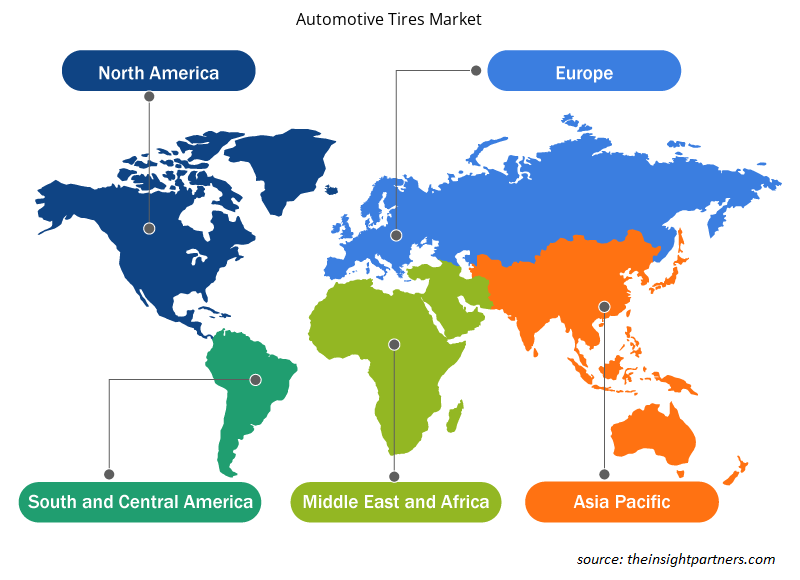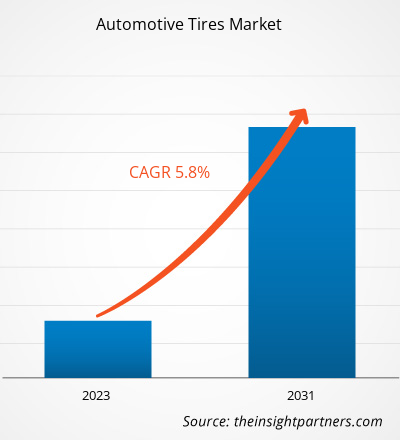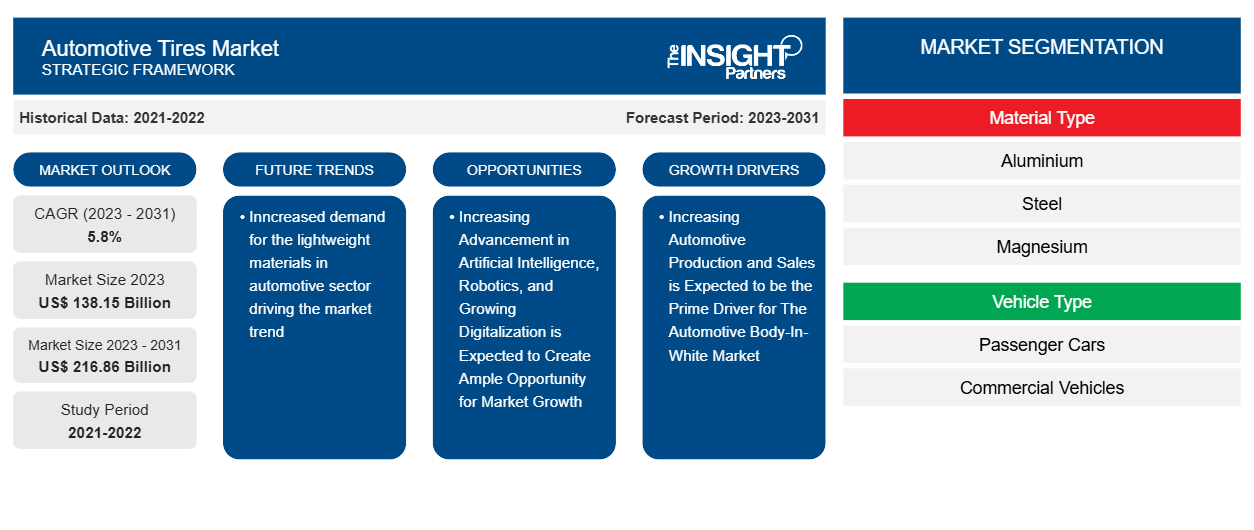Der Markt für Autoreifen soll von 138,15 Milliarden US-Dollar im Jahr 2023 auf 216,86 Milliarden US-Dollar im Jahr 2031 anwachsen. Der Markt soll in den Jahren 2022–2031 eine durchschnittliche jährliche Wachstumsrate von 5,8 % verzeichnen. Die weltweit steigende Automobilproduktion und -verkäufe sowie strenge Regeln und Vorschriften für nachhaltige Materialien für Reifen treiben das Marktwachstum an. Laut den Verbänden der Automobilindustrie wurde der weltweite Automobilherstellungssektor im Jahr 2022 auf rund 2,86 Billionen US-Dollar geschätzt und soll bis 2026 3,2 Billionen US-Dollar erreichen. Dieses Wachstum ist in erster Linie auf den steigenden Verkauf von Neuwagen an Verbraucher auf der ganzen Welt zurückzuführen.
Marktanalyse für Autoreifen
Der Markt für Autoreifen wird durch steigende Autoverkäufe und -produktion sowie das schnelle Wachstum von Geländefahrzeugen in der Landwirtschaft und im Bergbau angetrieben. Geländefahrzeuge sind Verschleiß ausgesetzt. Daher ist die Nachfrage nach Autoreifen für diese Geländefahrzeuge hoch. Der rasant wachsende Bausektor sowie die steigende Nachfrage aus Entwicklungsländern auf der ganzen Welt sind die Hauptantriebsfaktoren für das Marktwachstum. Autoreifen müssen nach einer bestimmten Zeit gewechselt werden. Auch steigende Autoverkäufe und steigende Nutzfahrzeugverkäufe bei den Verbrauchern führten zu einer massiven Nachfrage nach Wachstum auf dem Markt für Autoreifen. Der Verkauf von Personenkraftwagen hat den größten Anteil am Gesamtmarkt. Die weltweiten Kraftfahrzeugverkäufe sind von 2020 bis 2021 um 5 % gestiegen. Ein solches Wachstum der weltweiten Automobilverkäufe dürfte im Prognosezeitraum reichlich Gelegenheit für das Marktwachstum schaffen.
Passen Sie diesen Bericht Ihren Anforderungen an
Sie erhalten kostenlose Anpassungen an jedem Bericht, einschließlich Teilen dieses Berichts oder einer Analyse auf Länderebene, eines Excel-Datenpakets sowie tolle Angebote und Rabatte für Start-ups und Universitäten.
-
Holen Sie sich die wichtigsten Markttrends aus diesem Bericht.Dieses KOSTENLOSE Beispiel umfasst eine Datenanalyse von Markttrends bis hin zu Schätzungen und Prognosen.
Treiber und Chancen auf dem Autoreifenmarkt
Steigende Verkäufe von Nutzfahrzeugen und Personenkraftwagen treiben das Marktwachstum voran
Steigende Automobilverkäufe und -produktion in Entwicklungsländern, darunter China, Indien, Mexiko, Brasilien und Japan, treiben den Autoreifenmarkt im Prognosezeitraum an. Laut der China Association of Automobile Manufacturers Organization stiegen die Pkw-Verkäufe im März 2023 auf über 1,05 Millionen Einheiten, was einer Steigerung von 20,4 % gegenüber dem Vormonat 2023 entspricht. Auch steigende globale Automobilverkäufe auf der ganzen Welt treiben das Wachstum des globalen Autoreifenmarktes an. Laut der Internationalen Energieagentur erreichte die weltweite Automobilproduktion im Jahr 2023 93,0 Millionen Einheiten, ein Anstieg von 11,2 % gegenüber 2022. Ein solches Wachstum bei Automobilproduktion und -verkäufen hat im Prognosezeitraum eine enorme Nachfrage nach dem Marktwachstum geschaffen.
Die zunehmende Entwicklung des intelligenten Systems zur Überwachung des Reifendrucks dürfte im Prognosezeitraum reichlich Gelegenheit für ein Wachstum des Autoreifenmarktes schaffen.
Fortschritte in der Autoreifenherstellung, wie die Integration intelligenter Reifen mit eingebauten Sensoren zur Senkung der Gesamtfahrkosten, treiben die Marktchancen voran. Mehrere wichtige Marktteilnehmer wie Continental AG und Hankook investieren in diese fortschrittlichen Technologien, um sicheres Fahren zu ermöglichen und die Fahrzeugeffizienz zu verbessern. Intelligente Reifen überwachen genaue Druck- und Temperaturwerte von Sensoren im Innenfutter des Reifens. So brachte Continental AG im Februar 2023 Conti Connect Tire mit Live auf den Markt, eine cloudbasierte Lösung, die Flotten in Echtzeit unterstützt. Es ist mit einem intelligenten digitalen Reifenüberwachungssystem für die Fahrzeuge der Flotte ausgestattet. Continental-Reifen verfügen über Sensoren zur Datenerfassung im Inneren der Reifen.Hankook, are investing in these advanced technologies to offer safe driving and enhance vehicle efficiency. Intelligent tires monitor accurate Conti Connect Tire with Live cloud-based solution assistance in the fleets in real-time. It is built with an intelligent digital tire monitoring system for the vehicles in the fleet. Continental tires consist of sensors to collect data inside the tires.
Segmentierungsanalyse des Marktberichts für Autoreifen
Wichtige Segmente, die zur Ableitung der Marktanalyse für Autoreifen beigetragen haben, sind Fahrzeugtyp, Felgengröße, Design und Reifentyp.
- Basierend auf dem Fahrzeugtyp ist der Markt in Personenkraftwagen, leichte Nutzfahrzeuge und schwere Nutzfahrzeuge unterteilt. Unter diesen haben Personenkraftwagen im Jahr 2023 den größten Anteil.
- Basierend auf der Felgengröße ist der Markt in 13''-15'', 16''-18'', 19''-21'', über 21'' unterteilt.
- Basierend auf dem Design wird der Markt in radiale und schräge unterteilt. Darunter hat das radiale Design im Prognosezeitraum 2023 den größten Anteil.
- Basierend auf dem Reifentyp ist der Markt in schlauchlose Reifen und Reifen mit Schlauch unterteilt.
Marktanteilsanalyse für Autoreifen nach Geografie
Der geografische Umfang des Marktberichts für Autoreifen ist hauptsächlich in fünf Regionen unterteilt: Nordamerika, Europa, Asien-Pazifik, Naher Osten und Afrika sowie Südamerika.
Aufgrund der steigenden Fahrzeugverkäufe in dieser Region wird der asiatisch-pazifische Raum im Prognosezeitraum voraussichtlich den Markt dominieren. Führende Länder wie Indien, Japan und China treiben das Wachstum des Autoreifenmarktes im Prognosezeitraum voran. Dies ist in erster Linie auf die gestiegene Nachfrage der riesigen Bevölkerungsbasis in China und Indien zurückzuführen, die die Hauptantriebsfaktoren für das Wachstum des Autoreifenmarktes in Indien und China sind.
Aufgrund steigender Autoverkäufe und eines höheren verfügbaren Einkommens der Bevölkerung in dieser Region verzeichnet auch der Markt für Autoreifen in Europa ein rasantes Wachstum.
Regionale Einblicke in den Markt für Autoreifen
Die regionalen Trends und Faktoren, die den Autoreifenmarkt im Prognosezeitraum beeinflussen, wurden von den Analysten von Insight Partners ausführlich erläutert. In diesem Abschnitt werden auch die Marktsegmente und die Geografie des Autoreifenmarkts in Nordamerika, Europa, im asiatisch-pazifischen Raum, im Nahen Osten und Afrika sowie in Süd- und Mittelamerika erörtert.

- Erhalten Sie regionale Daten zum Autoreifenmarkt
Umfang des Marktberichts für Autoreifen
| Berichtsattribut | Details |
|---|---|
| Marktgröße im Jahr 2023 | 138,15 Milliarden US-Dollar |
| Marktgröße bis 2031 | 216,86 Milliarden US-Dollar |
| Globale CAGR (2023 - 2031) | 5,8 % |
| Historische Daten | 2021-2022 |
| Prognosezeitraum | 2023–2031 |
| Abgedeckte Segmente |
Nach Materialtyp
|
| Abgedeckte Regionen und Länder |
Nordamerika
|
| Marktführer und wichtige Unternehmensprofile |
|
Marktteilnehmerdichte: Der Einfluss auf die Geschäftsdynamik
Der Markt für Autoreifen wächst rasant, angetrieben durch die steigende Nachfrage der Endverbraucher aufgrund von Faktoren wie sich entwickelnden Verbraucherpräferenzen, technologischen Fortschritten und einem größeren Bewusstsein für die Vorteile des Produkts. Mit steigender Nachfrage erweitern Unternehmen ihr Angebot, entwickeln Innovationen, um die Bedürfnisse der Verbraucher zu erfüllen, und nutzen neue Trends, was das Marktwachstum weiter ankurbelt.
Die Marktteilnehmerdichte bezieht sich auf die Verteilung der Firmen oder Unternehmen, die in einem bestimmten Markt oder einer bestimmten Branche tätig sind. Sie gibt an, wie viele Wettbewerber (Marktteilnehmer) in einem bestimmten Marktraum im Verhältnis zu seiner Größe oder seinem gesamten Marktwert präsent sind.
Die wichtigsten auf dem Markt für Autoreifen tätigen Unternehmen sind:
- ABB Ltd.
- Benteler International AG
- CIE Automobile
- Dura Automotive Systems
- Gestamp Automocion SA
- Kuka AG
Haftungsausschluss : Die oben aufgeführten Unternehmen sind nicht in einer bestimmten Reihenfolge aufgeführt.

- Überblick über die wichtigsten Akteure auf dem Autoreifenmarkt
Neuigkeiten und aktuelle Entwicklungen zum Autoreifenmarkt
Der Markt wird durch die Erhebung qualitativer und quantitativer Daten nach Primär- und Sekundärforschung bewertet, die wichtige Unternehmensveröffentlichungen, Verbandsdaten und Datenbanken umfasst. Im Folgenden finden Sie eine Liste der Entwicklungen auf dem Markt für Autoreifen und der Strategien:
- Im Januar 2023 ging Sumitomo Rubber Industries eine Partnerschaft mit Global Data Service ein, um das Geschäft mit Autoreifen und Autokomponenten auszubauen. Der Autoreifenhersteller hat es seinen Benutzern ermöglicht, mithilfe der RFID-Technologie auf Daten über Reifen zuzugreifen. (Quelle: DJI, Pressemitteilung/Unternehmenswebsite/Newsletter)
- Im Oktober 2022 stellte Hankook Tire den AU06+ Smart iON Radialreifen für Lkw und Busse für Premium-Elektrofahrzeuge vor. (Quelle: DJI, Pressemitteilung/Unternehmenswebsite/Newsletter)
Marktbericht zu Autoreifen – Umfang und Ergebnisse
Der Bericht „Marktgröße und Prognose für Autoreifen (2021–2031)“ bietet eine detaillierte Analyse des Marktes, die die folgenden Bereiche abdeckt:
- Marktgröße und Prognose auf globaler, regionaler und Länderebene für alle wichtigen Marktsegmente, die im Rahmen des Projekts abgedeckt sind
- Marktdynamik wie Treiber, Beschränkungen und wichtige Chancen
- Wichtige Zukunftstrends
- Detaillierte Porter's Five Forces Analyse
- Globale und regionale Marktanalyse mit wichtigen Markttrends, wichtigen Akteuren, Vorschriften und aktuellen Marktentwicklungen
- Branchenlandschaft und Wettbewerbsanalyse, einschließlich Marktkonzentration, Heatmap-Analyse, prominenten Akteuren und aktuellen Entwicklungen
- Detaillierte Firmenprofile mit SWOT-Analyse
- Historische Analyse (2 Jahre), Basisjahr, Prognose (7 Jahre) mit CAGR
- PEST- und SWOT-Analyse
- Marktgröße Wert/Volumen – Global, Regional, Land
- Branchen- und Wettbewerbslandschaft
- Excel-Datensatz
Aktuelle Berichte
Erfahrungsberichte
Grund zum Kauf
- Fundierte Entscheidungsfindung
- Marktdynamik verstehen
- Wettbewerbsanalyse
- Kundeneinblicke
- Marktprognosen
- Risikominimierung
- Strategische Planung
- Investitionsbegründung
- Identifizierung neuer Märkte
- Verbesserung von Marketingstrategien
- Steigerung der Betriebseffizienz
- Anpassung an regulatorische Trends























 Kostenlose Probe anfordern für - Markt für Autoreifen
Kostenlose Probe anfordern für - Markt für Autoreifen